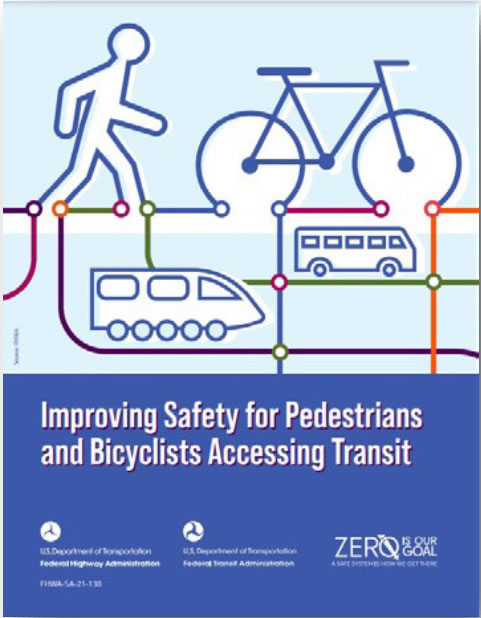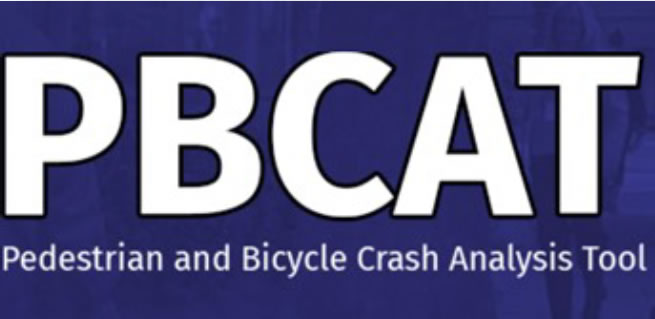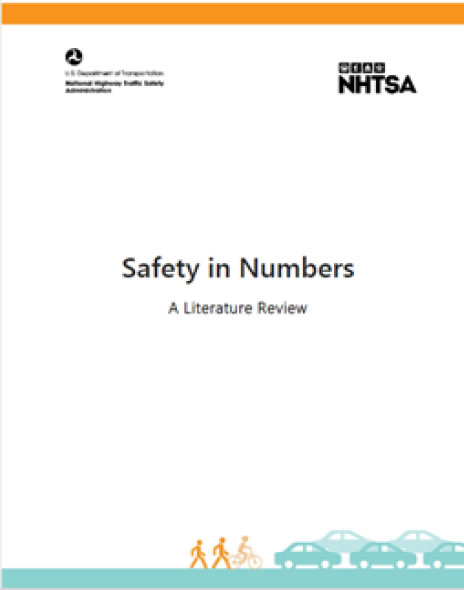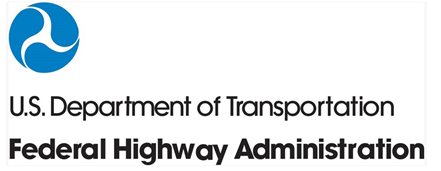U.S. Department of Transportation
Federal Highway Administration
1200 New Jersey Avenue, SE
Washington, DC 20590
202-366-4000

Photographer: Dan Burden
www.pedbikeimages.org/

U.S. Department of Transportation
Federal Highway Administration
Fall 2022
Downloadable PDF [527 KB]
In this issue:
Vulnerable Road User Assessment Guidance
Pedestrian and Bicyclist Safety Information Search Tool
New! PBCAT Pedestrian and Bicycle Crash Analysis Tool Version 3.0 User Guide
New Roadway Lighting Resources
NEW! Safety In Numbers: A Literature Review

The Federal Highway Administration (FHWA) and Federal Transit Administration (FTA) recently released Improving Safety for Pedestrians and Bicyclists Accessing Transit. This new guide is intended for transit agencies, State and local roadway owners, and regional planning organizations. In addition to identifying how access to and the use of transit has changed, including the range of modal choices, this guide addresses the safety of a variety of vulnerable road users, such as pedestrians, bicyclists, and micromobility users.
The guide includes three fundamentals agencies can use:
Transit agencies may take internal actions to foster a culture of safety, form partnerships with public agencies and public-private organizations, as well as implement engineering and operational actions to enhance and improve pedestrian and bicyclist safety near transit stations. The guide describes several internal actions transit agencies may employ to enhance traffic safety.
A webinar was held on October 24 on the new transit guide. The recording can be accessed here. details of the guide, including why this guide is needed and tips and best practic- es for agencies to use in their day-to-day work were ad- dressed. Case studies from the Oregon Department of Transportation and the City of Pittsburgh/Pittsburgh Regional Transit were also discussed.
The guide highlights the many engineering and operational efforts agencies can take to improve safety for pedestrians and bicyclists while accessing transit. This section of the guide is divided into transit access and transit stop/station improvements, and it provides detailed information (including illustrations, technical specifications, and links to other resources) to help you implement these improvements in your transportation facilities.
For more info: tamara.redmon@dot.govThe FHWA announced new guidance to help states address the crisis of non-motorized roadway deaths across our nation as part of its ongoing efforts to prioritize safety and meet milestones laid out in the Bipartisan Infrastructure Law. Vulnerable road users, such as pedestrians, bicyclists, and people who use wheelchairs, accounted for approximately 20% of the 42,915 people who were killed in motor vehicle crashes in 2021, according to the National Highway Safety Traffic Administration (NHTSA).
The guidance will provide additional clarity for states as they develop their Vulnerable Road User Safety Assessment, a new safety approach established under President Biden’s Bipartisan Infrastructure Law to assess the safety performance of individual states, identify areas of high risk to vulnerable road users, and determine what safety improvements will mitigate these safety risks.
“Its up to all of us to keep those who walk, bike or roll safe as they travel,” said U.S. Transportation Secretary Pete Buttigieg. “Because of the Bipartisan Infrastructure Law, states have newresourcestoimprovesafety forvulnerabletravelers,makeour roadssaferandmoreaccessible for all, andhelp move us closer to reaching the ultimate vision of zero fatalities.”.
By law, the Vulnerable Road User Safety Assessments developed by states to identify areas of high risk must be driven by demographic and performance related data in consultation with local governments and community stakeholders that represent high risk areas as well. In developing these assessments, FHWA is encouraging states to work with institutional, advocacy, and community groups, particularly those that represent populations that are involved in these crashes and reside in the locations where fatalities and serious injuries are occurring.
FHWA encourages states to use their Vulnerable Road User Safety Assessment findings to adjust project selection and investment strategies. States will complete their Vulnerable Road User Safety Assessment by November 15, 2023 and include it as part of their State Strategic Highway Safety Plan (SHSP).
FHWA’s guidance on the assessment will help states follow that legal requirement as they work to reduce roadway fatalities and improve the safety of road users who walk, bike, roll and rely on access to transportation systems.
“It is up to all of us to keep those who walk, bike or roll safe as they travel,” said U.S. Transportation Secretary Pete Buttigieg.
“Because of the Bipartisan Infrastructure Law, states have new resources to improve safety for vulnerable travelers, make our roads safer and more accessible for all, and help move us closer to reaching the ultimate vision of zero fatalities.”
FHWA can provide a limited amount of free technical assistance to those who may need it. Contact tamara.redmon@dot.gov for more information on that.
“This guidance can help States identify what safety issues for those outside of a vehicle need to be addressed and where,” said Acting Federal Highway Administrator Stephanie Pollack. “States are then positioned to incorporate the results as they make decisions about their safety investments. It also improves transportation equity by making sure extensive dialogue with relevant stakeholders takes place and the concerns of those most at risk in towns, cities and underserved communities are heard through better public engagement at the local level.”
The FHWA's Safety Office just launched the updated Pedestrian and Bicyclist Safety Information Search Tool, a page-by-page assessment of more than 100 carefully selected reports, guidebooks, and training materials, cross-referenced by mode, the "Es" (Engineering, Education, Enforcement, Evaluation, Encouragement), topics addressed, and other categories.
Reports and guidance documents abound for anyone engaged in planning, designing, or advocating for safe pedestrian and bicycle facilities. The information packed into these resources is valuable, but practitioners must track it down from a wide variety of websites, clearinghouses, and printed documents. Not all documents are readily or freely available, and readers must sometimes assess on their own the quality of what they find.
Anyone with a web connection can search the library by typing keywords, picking from drop-down lists, or using other search filters available on the site. Whether you are a community member looking for ways to make your neighborhood safer for kids on bicycles, a researcher studying the application of safety countermeasures, a planner writing a local policy on multimodal safety, or an engineer designing a cycle track, this library can help you find the resources you need.

FHWA recently published PBCAT Pedestrian and Bicycle Crash Analysis Tool Version 3.0 User Guide. The report serves as the companion resource to assist those using PBCAT 3. PBCAT 3 is a crash typing software product intended to assist State and local pedestrian/bicycle coordinators, planners, and engineers with improving walking and bicycling safety.
The product is designed to help road safety professionals improve their understanding of non-motorist crashes. Users can upload and aggregate data locally. Through development and analysis of a database containing details associated with crashes between motor vehicles and pedestrians or bicyclists, transportation professionals can make their systems safe.
One of these crash-associated details is crash type, which describes the pre-crash actions of the involved parties. After developing a database of crash information from PBCAT output, the user can analyze the data to produce reports and help select countermeasures to address problem areas. The application also allows users to categorize their non-motorist crashes and create a data set for analysis. Version 3 is available online, free through th HSIS webpage. The updated version also features new graphics, logic, and considers micromobility in its analysis. The accompanying User Guide provides detailed information on how to use PBCAT.
For more information, please contact Ana Maria Eigen, D.Sc., HSIS Program Manager, ana.eigen@dot.gov.

Safety Benefits and Best Practices for Intersection Lighting: This project for the Virginia Department of Transportation involved an extensive effort to investigate traffic safety lighting impacts at intersections. Based on the results, the project identified optimal lighting levels for different types of intersections and developed guidelines to facilitate lighting needs analysis and design.
Roadway Lighting's Effect on Pedestrian Safety at Intersection and Midblock Crosswalks: This study for the Illinois Department of Transportation evaluated the visual performance of intersection and midblock crosswalk lighting designs along with two pedestrian safety countermeasures (rectangular rapid flashing beacons and flashing signs) at three light levels. The study also involved a pedestrian detection task, which was completed at night on a realistic roadway intersection and a midblock crosswalk.
For more information on pedestrian lighting, please contact Joseph Cheung at Joseph.cheung@dot.gov.
For more information contact Joseph.Cheung@dot.gov.
The FHWA Office of Safety held a webinar highlighting several new resources on Lighting for Pedestrians on July 19. The webinar discussed the im- portance of street lighting on pedestrian safety by sharing the research outcomes from the Research Report: Street Lighting for Pedestrian Safety and provided an overview of the Pedestrian Lighting Primer. The recording can be viewed here. Passcode: LLM?j2@^

NHTSA recently released Safety in Numbers: A Literature Review. In the context of pedestrian and bicyclist safety, “safety in numbers” (SIN) assumes that when walking and biking trips increase, the probability of motorist collisions with pedestrians and bicyclists goes down.
The literature review was conducted to summarize the state of research on SIN and identify potential implications of the work. The review chronologically describes research developing the SIN concept and subsequent work testing and expanding the theory. The literature review considers fields of study and areas of practice including engineering, planning and land use, sociology, psychology, education, public health, enforcement, human factors, and others. This breadth was especially important due to the broad target audience of this report who may apply the literature review results to their own future practice. These include State Highway Safety
Offices, national organizations interested in the SIN topic, planners, engineers, educators, advocacy groups, policymakers, State DOTs, metropolitan planning organizations, and roadway users — motorists, pedestrians, bicyclists — and law enforcement professionals.
This literature review also identified a sample of programs and initiatives at transportation and advocacy organizations that work to increase pedestrian and bicyclist travel and safety. Many of these agencies have measures of success–whether that be implementing programs or initiatives, seeing increases in bicyclist and pedestrian volumes, and/or decreasing bicyclist and pedestrian crash rates. However, program evaluation results are not formally published or do not make the correlation between an increase in pedestrian and bicyclist volume and reduced crashes, or the other factors that may influence SIN. Further, this review showed that the SIN theory is more commonly referred to and used in academia than in practice. More information on the underlying explanatory factors could be useful to help transportation practitioners integrate the SIN theory into their planning and policy.
Bottom line: there has been research both supporting and critically reviewing the SIN concept, and the increasing agreement in the research is that the effect exists. The majority of the available literature affirms that there is a SIN effect for both bicyclists and pedestrians, supported by a non-linear relationship between pedestrian and bicyclist exposure and crash risk. The effect differs by mode, with bicyclists appearing to have a stronger effect than pedestrians.

This Pedestrian and Bike Forumis available on the Web at
https://safety.fhwa.dot.gov/ped_bike/pedforum/
Scroll down to “Pedestrian and Bicycle Safety” and select “subscribe” next to “Pedestrian Forum.”

Tamara Redmon, Pedestrian Safety Program
Manager
Federal Highway Administration
1200 New Jersey Avenue SE
Room E71-303
Washington, DC 20590
Phone: 202-366-4077
Fax: 202-366-3222
E-mail: tamara.redmon@dot.gov
To receive information on future newsletters, please use the e-subscription service provided on this site: https://public.govdelivery.com/accounts/USDOTFHWA/subscriber/new?topic_id=USDOTFHWA_102

